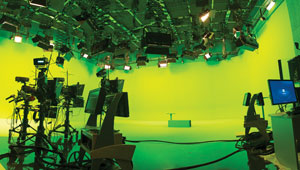RT's new HD studios
Since the launch of its flagship news channel in 2005, Moscow-based RT (formerly Russia Today) has grown to include five international TV channels, a video agency and a massive new media presence, expanding its reach to 630 million people across five continents. Known for being an alternative voice on the news media landscape, RT has built a worldwide audience that expects breaking stories, sharp insight and professional presentation from the network.
Growth constraints
The broadcaster’s rapid growth brought burgeoning challenges. It had outgrown its legacy production facility, which was never intended to accommodate either the multimedia, round-the-clock broadcasts in English, Arabic and Spanish, or its 2000 staff members. The broadcaster’s technological base, too, had become inadequate for efficient management and exchange of data between multiple channels and delivery platforms. Finally, it was essential for RT to switch all of its broadcasts to HD in order to remain an industry leader.

In RT’s new broadcast control room, staff monitor all outgoing feeds on video walls that accommodate the network’s new HD format on its current channels, and potential future channels.
The goal was set: to create a brand-new, state-of-the-art studio complex that would accommodate the network’s five current and potential future channels, as well as streamline the information exchange between a number of old media and new media platforms; to do this in the shortest possible time; and to seamlessly migrate the round-the-clock broadcasts to HD in real time, without any disruptions for the audience.
Consolidation and repurposing
RT asked systems integrator Okno-TV to develop the new space practically from the ground up and outlined several essential requirements. All routine operations had to be optimized and made uniform across the entire facility. Efficient media repurposing had to be enabled. The broadcaster uses more than 40 incoming satellite and terrestrial feeds. It needed a centralized ingest with a unified descriptive scheme and on-demand distribution to production teams and facilities.
The professional video industry's #1 source for news, trends and product and tech information. Sign up below.
Furthermore, RT does not simply dub its stories into multiple languages; it also reworks and reformats ready-to-air materials for specific regions, as well as for websites, social media and free video portals.
Okno-TV’s experts were tasked with finding an innovative solution that would enable RT, and especially its new media team, to publish news packages and their descriptive data directly from the broadcaster’s production systems to those portals.
New space
Preliminary discussions and selection of the technical architecture took place during 2011. Teams of engineers, designers and management jointly developed solutions for many aspects of the project, including site selection and building reconstruction (a retired industrial space spread across three buildings had to be adapted for efficient, high-tech television production); ergonomic facility planning and design; technological concept; and redesign of workflows.

Shotoku cameras support the English-language channel, which was the first to transition to HD.
The project started in November 2011, and over the course of the next 13 months, more than 28,000sq m of indoor and outdoor space were reconstructed, with more than 150 installers working simultaneously on site at peak time. Some of the systems were inherited from the legacy RT setup, like the use of Ikegami cameras in the studios, but most of the approaches were adapted for the first time. The best field engineering resources from vendors such as Control Systems, Dalet, Evertz, Harmonic, Harris, Hitachi Data Systems, Quantum, Riedel and Vizrt came together, and an international team of engineers worked to create a new home for the broadcaster, with six TV studios, a server room of more than 250 racks and HD broadcasting capability for eight simultaneous HD feeds.
The studios implement an open-space concept, with production-focused facilities sharing the space with the sound stage, and the entire space being optimized from the personnel flow perspective. Studios have automated tripods and Barco video walls, while offices framing the newsrooms are used as editing suites.
RT’s new HD facility contains separate studios for production of news programming in English, Arabic and Spanish.
The transition from the SD facility to the brand-new HD system was precisely planned and orchestrated. RT kept broadcasting from the legacy system while the personnel took part in extensive training and dry runs at the new facility. A number of questions and issues were resolved during the transition stage. In the course of the training, a number of suggestions from the RT staff were turned into reality by the experienced international engineering and
implementation team.
On Dec. 16, 2012, the broadcaster seamlessly switched all of its worldwide English-language broadcasting to the HD format. Remaining channels followed shortly after, with some doing a live sign-off from the old studios and greeting their viewers from the new location and in the new format only moments later.
One platform, two domains
The broadcaster houses two independent, but interacting, television centers within its structure: News Domain and Production Domain, with three studios — each with its own routing and control infrastructures — and four independent Dalet Enterprise Edition sites. The Dalet Enterprise Suite is a news production and media asset management platform that combines newsroom, production and media management features in one application. Two important aspects are format transparency and the ability to repurpose archived SD materials collected since 2005.
All incoming materials are processed by the Archive and Production (A&P) site. The key feature is consolidation of technical and human resources for ingest on one site and distribution of the prepared materials to other sites. This site is also used for archives’ storage and media management for the entire network. Archives are accessible via Web browser throughout the facility and to RT’s remote bureaus. The A&P site also supports three studios for the long-form and virtual studio programs.
Three separate sites were built for news production in English, Arabic and Spanish. Each version has its own unique look and feel, programming and special approach to the presentation. Thanks to the synchronization of the News and A&P domains, it is possible to move production of any one language version to the A&P site, allowing upgrades and expansions for the News site. This also enables RT to dynamically manage resources from both domains and to launch additional news channels in the future.
All media operations and distribution have been made fully transparent. Production teams are able to access a massive amount of thoroughly indexed and thus easily searchable materials, creating high-quality content from many different sources much faster than had ever been possible with the old setup.
Ingest
Media and descriptive metadata from 24 HD-SDI ingest ports are streamed continuously from the A&P sites to the News sites using “while scenarios,” which produce a delay of only 10 to 15 seconds from the moment the first image comes in as an HD-SDI signal until it is available to journalists. Notably, different creative and technical teams across the facility receive the same high-quality, English-language descriptions of media materials, allowing for timely decision-making. The A&P site also gathers and processes all the media coming as FTP/Internet transfers or from ENG crews. In addition, the common production platform allows users of different sites to search, browse and pull content from the neighboring sites, all via lightweight Web sessions.
Graphics and visuals
RT also wanted to centralize and maximally expedite its graphics creation process. Following an extensive elements analysis, most of the graphics were designed as templated scenes within the Vizrt environment, to be easily used by journalists and editors. This high level of integration allows several advantages in terms of quality of output, transparency and workflow efficiency. Journalists do not need to switch between different systems, and anyone can review the graphics and text at any point of time, including during review from the rundown, greatly reducing probability of errors.

A green-screen studio in the newly updated RT operation is used to create virtual sets.
For recurring visuals such as tickers and weather maps, automated data sources were introduced, minimizing the need for manual preparation. Production of more complex graphics is also fast-tracked, via playing a completed sequence as an SDI signal and recording it on the Telestream Pipeline appliance. This workflow allows graphical scenes with transitional logic inside the fastest way to Dalet sites and Avid post-production, and multiformat delivery of media for Internet publishing.
NLE consolidation
Twenty Adobe and Apple NLEs were consolidated into a common pool; each station was enabled to search and browse media databases at all four Dalet sites and to be flexibly allocated based on specific current needs. All stations also use an edit-in-place approach without the need of additional file transfers, saving a lot of time and storage resources.
One of the most challenging aspects of the project was development of an enormous HD-SDI infrastructure. Six studios, multichannel playout, its own teleport, centralized ingest — all located across three separate buildings — made the task incredibly complex. Riedel’s optical multiplex system was chosen for the distribution of a large volume of HD-SDI signals, AES/EBU streams, intercom and control signals. Approximately 56 MediorNet frames, more than had ever been used in Europe in a single location, were installed throughout the facility, creating a highly efficient multiservice optical network.
Routing
The Virtual Studio Manager system was deployed on site in order to automate and simplify control of the routing resources. There are two independent but interacting control domains and two redundant VSM systems that were configured to ensure the continuity of broadcasts sans technical breakdowns. Because of the flexibility of VSM, it became possible to execute very complex routing with just a few button presses.
Planning for the future
At the end, a close cooperation between RT and Okno-TV on every step of the process was key to successful execution of the complex task: creating a brand-new production facility for multi-platform news delivery concurrently with enabling a seamless switch to worldwide HD broadcast. The implemented solutions and overall design meet the demands not only of the global TV network as it stands today, but will accommodate the future growth and expansion.
Design team
- RT: Andrey Bukashkin, chief dir.; Alexey Dementiev, dir. of photography;
Alexander Ozersky, news prod. head. - Okno-TV (systems int.): Oleg Truschelev, proj. head; Konstantin Folomeev, proj. mgr.; Nikolay Bondarenko, dept. head; Denis Sukolenov, lead of eng. group
Technology at work
- Adobe: Premiere Pro editing software
- Apple: Final Cut Pro editing software
- Barco: Video walls
- Cisco: Catalyst and Nexus network switches
- Dalet Digital: Dalet Enterprise Edition NRCS, MAM master control switchers, SDI ingest, file ingest, transcoding, archive management, Brio server
- Evertz: EQX 576 x 576 router
- Front Porch Digital: DIVA content storage management
- Harmonic: Omneon MediaStore, MediaPort playout servers
- Harris: ADC 64 automation system
- Hitachi (HDS): Virtual Storage Platform
- HP: DL series servers
- Ikegami: Video monitors
- Lawo: mc2 66 audio consoles
- L|S|B: VSM Virtual Studio Manager
- Miranda: Imagestore 750 master control processor
- Quantum: StorNext file system
- Shotoku: Robotic cameras
- Vizrt: Viz Content Pilot, Viz Engines, Viz Curious Maps, Viz World graphics preparation and playout
- Riedel: MediorNet signal distribution
- Sony: Video monitors
- Telestream: Pipeline video recorder
- Tektronix: Test gear
- TVLogic: Video monitors
— Mikhail Kalanchekaev is executive director at Okno-TV, and Anna Belkina is chief press service specialist at RT.
